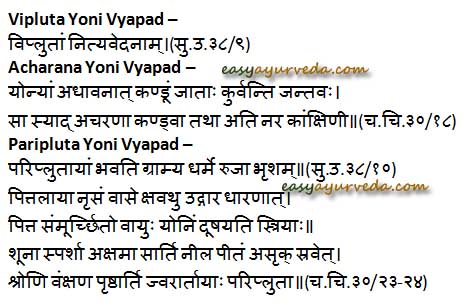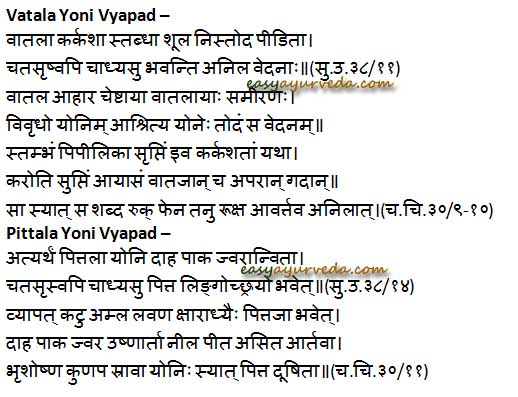Comparative Study Of PID With Yoni Vyapath
Article by Dr Raghuram Y.S. MD (Ay) & Dr Manasa, B.A.M.S
Pelvic Inflammatory Disease or PID is inflammation of female reproductive organs and pelvis. The inflammation usually happens after infection. Infection of vagina by Neisseria gonorrhoeae and or Chlamydia trachomatis gradually ascends into the uterus, fallopian tubes and ovaries and also into the pelvis and cause inflammation which leads to pain in lower abdomen, pain in pelvis, fever, vaginal discharges and other annoying symptoms.
Read related: Pelvic Inflammatory Disease: Causes, Symptoms, Pathogenesis, Diagnosis
Management of PID on the lines of treatment of Yoni Vyapad (treatment of diseases related to female genital system)
Yoni Vyapads are set of Vaginal disorders (broader meaning) occurring in female, 20 in number. They are explained in Ayurvedic texts and are dealt under separate chapters.
Yoni is a word which is equated to Vagina. But the term should be seen in a broader dimension. The term Yoni grossly comprises of female genital system including vagina, uterus, fallopian tubes and ovaries. All these structures are in closer proximity to the yoni and shall be considered as a single unit. Since these are pelvic organs, involvement of pelvis leading to pelvic pain and inflammation can be considered under the term Yoni Vyapad.
Even if we consider Yoni to be only ‘Vagina’, vagina forms the door way for all these structures. PID is a disease which starts with Yoni vis-à-vis vagina, but later involves uterus, fallopian tubes and ovaries along with pelvic cavity.
All Yoni Vyapads (20 in number) too starts with Yoni i.e. Vagina and are said to involve all the members of the female genital system and pelvis (at least in a few diseases). Some diseases or conditions explained in Yoni Vyapat Prakarana (chapters dealing with diseases related to female genital system i.e. vagina and uterus) closely resemble the clinical picture of Pelvic Inflammatory Disease. The general and specific treatments mentioned in these contexts too shall be taken into consideration while treating PID in an Ayurvedic way.
Read related: Pelvic Inflammatory Disease: Preventive measures, Home Remedies

Yoni Vyapads and PID
The conditions or subtypes of Yoni Vyapads explained in Yoni Vyapad Prakarana which closely resemble the clinical picture of PID are as below explained.
Table of Contents
Vipluta Yoni Vyapad
It is a type of Vataja Yoni Vyapad (vaginal or uterine disease caused by vitiation of Vata). Its symptom is Nitya Vedana i.e. presence of daily, constant pain. Pain in the uterus, vagina, fallopian tubes and pelvis is common symptom of PID. Vagbhata has said that Vipluta is caused by Krimis i.e. microorganisms or microbes (pathogens, bacteria). This puts Vipluta very closer to PID in its presentation and clinical picture.
Acharana Yoni Vyapad
Charaka’s description of Acharanaa Yoni Vyapad also is associated with the involvement of Jantu (microbes or bacteria) causing this condition. Charaka tells that Acharana Yoni Vyapad occurs due to unhygienic conditions of vagina (genital passage of women). This is caused due to lack of maintenance of vaginal health, non-cleansing of vaginal tract. The Jantus or krimis which get manifested as a result of unhygienic causes itching in vagina and excessive interest towards sexual activities.
Acharana doesn’t have pain and discomfort, but the unhygienic condition of vagina might lead to long standing infection and this infection may predispose to inflammation and pain as found in PID. Thus acharana might prove to be the causative condition for PID.
Read related: Pelvic Inflammatory Disease: Ayurvedic Treatment, Therapies, Medicines
Paripluta Yoni Vyapad
When the women who is of Pitta prakriti (constitution) and is habituated to consume pitta aggravating foods and lifestyle practices, happens to forcibly hold the impending urges (reflexes) of sneeze and belching during sexual intercourse, the pitta gets aggravated and enters Yoni along with vitiated Vayu. The vitiated pitta and vata on entering Yoni, vitiates the yoni and causes Paripluta Yoni Vyapad.
According to Sushruta, Paripluta is also a type of Vataja Yoni Vyapad. It is said that in Paripluta Yoni Vyapad, the pain in Yoni becomes severe following sexual intercourse (coitus). Even in PID we could find difficulty in having sex or pain during sex.
According to Vagbhata and Charaka, Paripluta is caused by combined vitiation of Vata and Pitta (Vata Pittaja).
Symptoms include –
- Shuna (swelling or inflammation)
- Sparsha akshama (tenderness)
- Arti (agonizing pain)
- Graamya dharma rujaa bhrusham (severe pain during intercourse)
- Shroni (Hip pain, pelvic pain)
- Vankshana (Pain in groin)
- Prishta vedana (Back pain, low back pain)
- Jwara (Fever)
- Neela peeta asruk sravet (blood with blue or yellow color flows out)

Paripluta seems to be the closest condition resembling PID
Vatala Yoni Vyapad
Vatala Yoni Vyapad is a type of Vataja Yoni Vyapad caused due to excessive vitiation of Vata. Vatala Yoni Vyapad is said to manifest mainly in the Vata constitution women. On consuming Vata vitiating foods and lifestyle practices the Vayu gets vitiated and causes pain and pricking sensation and other symptoms of Vata on entering Yoni.
Symptoms include –
- Karkasha (roughness in genital passages)
- Stabdhataa (stiffness in the reproductive organs, lower abdomen and pelvis)
- Shula (pain, colicky in nature)
- Toda (pricking pain)
- Pipeelikaa Sruptim iva (feeling of ants crawling in the genital tract
- Supti (numbness)
- Aayaasa (fatigue, tiredness)
- Sa shabda ruk phena tanu rooksha aartava – menstrual blood which looks diluted, dry, frothy flows with pain and sound
All these symptoms are seen to be present in PID.
Pittala Yoni Vyapad
Pittala Yoni Vyapad is a type of Pittaja Yoni Vyapad (vaginal or uterine disease caused by predominant vitiation of Pitta). It is caused due to excessive consumption of katu (spices, pungent foods), amla (sour foods), lavana (excessive salt), kshaara (excessive alkaline foods) and other foods and lifestyle practices which vitiate pitta.
Symptoms include –
- Daaha (burning sensation in the uterus, vagina, lower abdomen and pelvic region)
- Paaka (suppuration or formation of pus due to infection and inflammation)
- Jwara (fever)
- Ushnaarta – feeling of heat (raised heat)
- Neela peeta, asita, aartava, bhrusha ushna, kunapa sraava (menstrual blood will have blue, yellow and white color, hot in nature and foul smell is discharged)
These symptoms suggest inflammation and are also found in PID.
Note – The symptoms in the above mentioned conditions should be understood to be present in the regions near to yoni i.e. lower abdomen and pelvis.
Yoni Vyapad Chikitsa
Management of PID on the lines of Yoni Vyapad Chikitsa (treatment of vaginal or uterine disorders)
Principle of treatment –
In Yoni Vyapad (in general), the woman should be administered Panchakarmas i.e. 5 treatments in a milder form after administering snehana (oleation) and swedana (sweating treatment, sudation).
The panchakarmas are –
- Vamana – therapeutic emesis
- Virechana – therapeutic purgation
- Asthapana vasti – decoction enemas
- Anuvasana Vasti – oil enemas
- Nasya – nasal medication
Practically Virechana and Vasti (Asthapana and Anuvasana) are beneficial in combating PID.
Treatment of Vatala Yoni Vyapad –
- Vatanashaka Chikitsa – Treatments mentioned to cure Vata Vyadhi (specific disorders caused by vata vitiation) – including snehana, swedana, virechana, vasti etc
- Swedana – steaming (sudation) should be provided to Yoni through Nadi Sweda (tubular fomentation) and Kumbhi Sweda (pitcher fomentation) methods. Vata alleviating medicines (herbs) processed with audaka mamsa (aquatic animals) and anupa mamsa (animals living in marshy areas) or milk processed with rice and sesame should be used for swedana.
Alternatively oil mixed with salt should be applied to yoni and sudation should be given through fumes or steam coming through hot iron balls, stones or sand.
- Snana and ahara – After snehana and Swedana, the woman shall be given with hot water bath. After bath she shall be provides with food along with meat soup processed with vata alleviating medicines.
- Parisheka – Sprinkling or showering or stream pouring of hot and unctuous liquids will help in alleviating pain and inflammation.
- Abhyanga and Pichu – massage with herbal oils like Bala Taila and plugging of yoni with sterile cotton soaked in herbal oils will help in PID
Note – Paripluta and Vipluta Yoni Vyapats also should be treated on the lines of Vataja Yoni Vyapad since they are types of Vatala Yoni Vyapad.
Treatment of Pittala Yoni Vyapad –
- Parisheka – Stream pouring or sprinkling (showering) medicated liquids processed with pitta destroying and cold potency herbs
- Abhyanga – Massage with herbal oils processed with pitta destroying and cold potency herbs
- Pichu Dharana – Plugging of genital passages with sterile cotton soaked in oils or ghee processed with pitta destroying and cold potency herbs
- Swedana – Fomentation or sudation with pitta alleviating ghee like Shatavari ghrita, Jeevaneeya ghrita etc
Treatment of Acharana Yoni Vyapad –
- Uttara Vasti – Enema through vaginal route should be given with oil prepared from Jeevaneeya group of herbs
- Utkaarikaa – Warm semisolid pastes made up of Shatahva (Dil seeds), Yava (Barley), Godhuma (Wheat), Surakitta (waste product or sediment of medicated alcohol preparation), Kushta (Saussurea lappa), Priyangu (Callicarpa macrophylla), Bala (Sida cordifolia) and Aakhuparni (Merremia emarginata) should be applied in yoni.
PID also shall be treated on lines of doshic pattern, i.e. depending on the signs and symptoms of predominant dosha causing pain and inflammation in PID.
For better results, the treatment on lines of Yoni Vyapad Chikitsa as explained in this article can be effectively blended with ‘doshic pattern approach’ as given in the above said link.
Just Before Finishing –
Yoni Vyapads are different conditions occurring in women, under whom diseases related to female reproductive system including vagina, uterus, fallopian tubes and ovaries are studied. The conditions include painful conditions of female genitalia and pelvis to conditions like habitual abortion and infertility. Certain conditions explained in Yoni Vyapad resemble the signs and symptoms of PID. The causative factors given for the same also resemble with the causes of PID. It is essential to have a thorough knowledge of these conditions while treating PID in Ayurvedic way. This article highlights the signs and symptoms and treatment strategies of those conditions of Yoni Vyapad which closely resemble PID.
Medicinal Formulations mentioned in Sahasra Yoga Text Book For Yoni Roga
Maha Rasnadi Kashaya
Sukumara Ghrita
Varahyadi ghrita
Dhanwantara Taila
Sahacharadi Taila
Satavari Guda
Yoni soolahara Kashaya
Amritaprasa Ghrita
Mahamayura Ghrita
Click to Consult Dr Raghuram Y.S. MD (Ayu)









